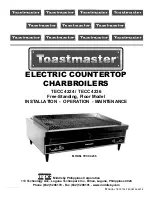
User manual HRE-serie version 6, November 2013
9
Figure 3
Figure 4
The flue can be installed in several different ways. You must carefully consider under which
circumstances the boiler will be used. For sea going boats and sail boats we advise the installation of a
vertical flue where the heel angles of the boat may be larger. The following installation examples are
most common.
HORIZONTAL FLUE GAS OUTLET
It is possible to fit a horizontal flue gas outlet to the boiler. The following points need to be observed:
Make sure that the outlet is positioned at a sufficient
height above the waterline. If this is not possible use a
swan neck bend in the pipe as in figure 3.
Use the correct hull fittings for installing the flue through
a hull side
The maximum allowed length is 5 meters.
Don’t use more than 3 elbows of 90°.
Every elbow of 90° is equivalent to 1 meter straight pipe
VERTICAL FLUE GAS OUTLET
This way if installation is preferable for seagoing boats and sailing boats, because these boats
encounter large angles of heel through waves and under sail. For this kind of flue gas outlet, the
following points are important:
Install a proper storm cowl on top of the chimney (this
must stop rain from entering) (figure 4).
Install deck fittings for installing the flue through a deck.
Install a water trap, to drain possible water caused by
condensation
Keep the chimney as vertical as possible.
Don't use more than 3 elbows 90°.
The maximum allowed length is 7 meters.
Every elbow of 90° counts as 1 meter.
Use outside double walled chimney pipe
Hint:
To reduce the noise from flames,
it is wise to install a silencer in the
flue.
Your Kabola supplier can provide you with all components
which may be required for installation such as:
Cowls;
Flexible piping;
Single and double walled chimney pipes;
Hull and deck fittings;
Silencers;
Water traps;
Insulation.









































